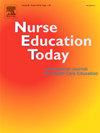Student midwives' experiences of high-fidelity simulation in midwifery education in the university setting: A qualitative systematic review
IF 4.2
2区 医学
Q1 EDUCATION, SCIENTIFIC DISCIPLINES
引用次数: 0
Abstract
Background
High- Fidelity Simulation is an increasingly popular, evidence-based, and technologically sophisticated pedagogical approach within nursing and midwifery education and simulated practice learning. Various systematic reviews exploring the effectiveness of High- Fidelity Simulation have been undertaken, yet there is limited evidence and no current systematic review about student midwives' experiences of High- Fidelity Simulation. Due to this lack of evidence, the proposed review into student midwives' experiences of High- Fidelity Simulation is highly justified. This review aims to provide new insights into this pedagogical approach within midwifery education and shape recommendations to assist midwifery educators to deliver high-quality High-Fidelity Simulation.
Aim
To explore what is known about the experiences of student midwives who have engaged in High- Fidelity Simulation as part of their midwifery education within the university setting.
Design and methods
The Joanna Briggs Institute (JBI) methodology for qualitative systematic reviews was followed and the study is reported using the Preferred Reporting Items for Systematic review and Meta-Analysis (PRISMA) guidelines.
Results/findings
The review found High- Fidelity Simulation to be a beneficial learning process, however some negative experiences were also identified. Two main themes emerged related to barriers and facilitators. Facilitators included the following seven subthemes: practical skill development, authenticity of the manikin and surroundings, application of theory to practice, increased confidence, practicing in a safe learning environment, improved team working skills, and the value of feedback. Barriers included the following 5 subthemes: a lack of realism, stress and pressure whilst role playing, anxiety, feelings of guilt, shame and decreased self-esteem, and group allocation.
Conclusions
Overall, the synthesized findings highlight that student midwives perceive the use of High- Fidelity Simulation to be highly beneficial, positively impacting their clinical competence and team working skills. Moreover, if High- Fidelity Simulation was used consistently and alongside adequate preparation and debriefing processes any unnecessary emotional harm could be avoided. Therefore, the application of High-Fidelity Simulation has the potential to develop a midwifery workforce that is better equipped to practice safely and more effectively at the point of registration, which could reduce mortality and morbidity rates for women and babies.
学生助产士在大学助产教育中高保真模拟的经验:一项定性的系统回顾
在护理和助产学教育和模拟实践学习中,高保真模拟是一种日益流行的、以证据为基础的、技术成熟的教学方法。各种探索高保真模拟有效性的系统综述已经开展,然而,关于学生助产士的高保真模拟经验的证据有限,目前没有系统综述。由于缺乏证据,建议审查学生助产士的经验,高保真模拟是高度合理的。本综述旨在为助产教育中的这种教学方法提供新的见解,并提出建议,以协助助产教育工作者提供高质量的高保真模拟。目的探讨作为大学助产学教育的一部分,从事高保真模拟的学生助产士的经验。设计和方法遵循乔安娜布里格斯研究所(JBI)的定性系统评价方法,并使用系统评价和荟萃分析(PRISMA)指南的首选报告项目进行研究报告。结果/发现回顾发现高保真模拟是一个有益的学习过程,但也发现了一些消极的经验。出现了两个与障碍和促进因素有关的主题。主持人包括以下七个主题:实用技能发展、假人与环境的真实性、理论与实践的应用、增强信心、在安全的学习环境中练习、提高团队合作技能,以及反馈的价值。障碍包括以下5个主题:缺乏现实主义,角色扮演时的压力和压力,焦虑,内疚感,羞耻感和自尊心下降,以及群体分配。总的来说,综合研究结果强调,助产士学生认为使用高保真模拟是非常有益的,对他们的临床能力和团队合作技能有积极的影响。此外,如果始终如一地使用高保真模拟,并与充分的准备和汇报过程一起使用,则可以避免任何不必要的情感伤害。因此,高保真模拟的应用有可能培养一支助产士队伍,使其在登记时能够更安全、更有效地进行实践,从而降低妇女和婴儿的死亡率和发病率。
本文章由计算机程序翻译,如有差异,请以英文原文为准。
求助全文
约1分钟内获得全文
求助全文
来源期刊

Nurse Education Today
医学-护理
CiteScore
6.90
自引率
12.80%
发文量
349
审稿时长
58 days
期刊介绍:
Nurse Education Today is the leading international journal providing a forum for the publication of high quality original research, review and debate in the discussion of nursing, midwifery and interprofessional health care education, publishing papers which contribute to the advancement of educational theory and pedagogy that support the evidence-based practice for educationalists worldwide. The journal stimulates and values critical scholarly debate on issues that have strategic relevance for leaders of health care education.
The journal publishes the highest quality scholarly contributions reflecting the diversity of people, health and education systems worldwide, by publishing research that employs rigorous methodology as well as by publishing papers that highlight the theoretical underpinnings of education and systems globally. The journal will publish papers that show depth, rigour, originality and high standards of presentation, in particular, work that is original, analytical and constructively critical of both previous work and current initiatives.
Authors are invited to submit original research, systematic and scholarly reviews, and critical papers which will stimulate debate on research, policy, theory or philosophy of nursing and related health care education, and which will meet and develop the journal''s high academic and ethical standards.
 求助内容:
求助内容: 应助结果提醒方式:
应助结果提醒方式:


